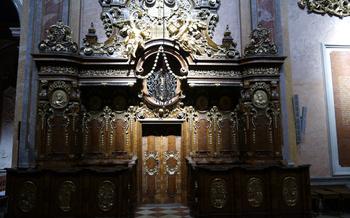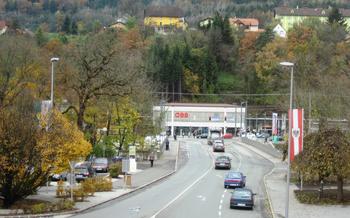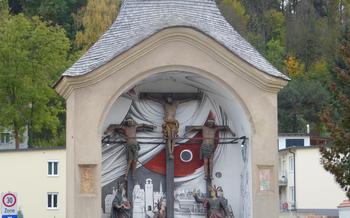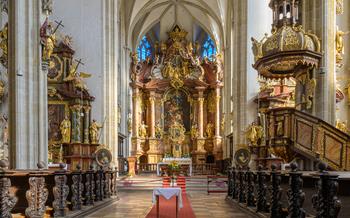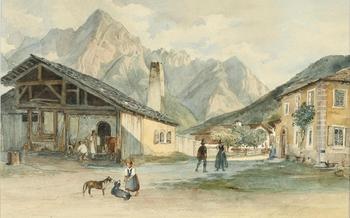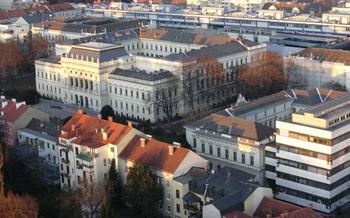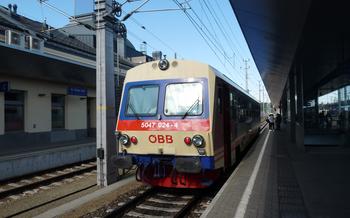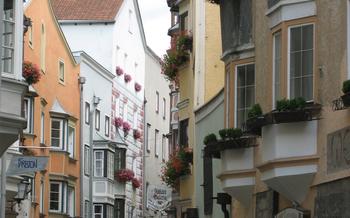
Mariahilferkirche (Church)
- History and Cultural Significance:
- Location:
- Architecture and Exterior
- Interior Design and Art
- Main Altar and Altarpiece
- Side Altars and Chapels
- Organ and Music
- Pilgrimage Site
- Festivals and Celebrations
- Local Legends and Stories
- Nearby Attractions
- Accessibility
- Photography and Videography
- Insider Tip: Unearth the Crypts and Hidden Staircase
History and Cultural Significance:
The Mariahilferkirche, also known as the Church of Our Lady of Grace, holds a prominent position in the religious and cultural landscape of Graz, Austria. Its history dates back to the 17th century, when the city was gripped by the horrors of the plague. In 1610, Archduke Ferdinand II, seeking divine intervention, commissioned the construction of a church dedicated to the Virgin Mary. The church was completed in 1617 and quickly became a symbol of hope and healing for the beleaguered city. Over the centuries, the Mariahilferkirche has undergone several renovations and expansions, reflecting the changing tastes and needs of the community. Today, it stands as a testament to the enduring faith and resilience of the people of Graz.
The architectural style of the Mariahilferkirche is a blend of late Renaissance and early Baroque, showcasing the transition between these two distinct periods. The church's facade is characterized by intricate carvings, statues, and a grand entrance portal, while the interior features soaring vaults, ornate frescoes, and opulent altars. The church's unique design and rich ornamentation reflect the artistic and cultural influences that shaped Graz during the 17th and 18th centuries.
Location:
The Mariahilferkirche is situated in the heart of Graz, Austria, at Mariahilferplatz Its prominent location makes it easily accessible for visitors exploring the city's historic center. To reach the church, you can take a leisurely stroll through the charming streets of Graz or utilize public transportation. Several bus lines, including the 31, 32, 34, and 58, stop within walking distance of the church. Additionally, the Graz Hauptbahnhof (main train station) is approximately a 15-minute walk away, offering convenient access for those arriving by train.
Once you arrive at Mariahilferplatz, you will be greeted by the impressive facade of the Mariahilferkirche. Its grandeur and architectural details are sure to captivate your attention. Take a moment to admire the church's exterior before stepping inside to explore its rich history, stunning artwork, and spiritual significance.
Architecture and Exterior
The Mariahilferkirche boasts an impressive exterior that reflects the grandeur of Baroque architecture. Its twin towers, reaching towards the sky, dominate the skyline of Graz. The intricate facade showcases a harmonious blend of curves and lines, adorned with sculptures and reliefs that narrate biblical stories and the lives of saints. The main portal, framed by ornate columns and a broken pediment, invites visitors into a realm of spiritual wonder. The dome, a symbol of divine authority, crowns the church, adding a touch of majesty to its overall appearance. These architectural elements combine to create a stunning exterior that captivates the hearts and minds of visitors, leaving them in awe of the church's grandeur.
Interior Design and Art
The interior of the Mariahilferkirche is a testament to the Baroque style's grandeur and opulence. Intricate frescoes, paintings, and sculptures adorn every surface, creating a feast for the eyes. The ceiling is covered in stunning frescoes depicting scenes from the life of the Virgin Mary and other biblical narratives. The walls are adorned with vibrant paintings and sculptures of saints, angels, and biblical figures, each one telling a unique story.
The most striking feature of the interior is the main altar, which is a masterpiece of Baroque craftsmanship. Elaborate carvings, gilding, and artwork create a sense of awe and wonder. The altarpiece, which depicts the Assumption of the Virgin Mary, is a focal point of the church and a testament to the skill of the Baroque artists.
The side altars and chapels are also adorned with beautiful artwork and sculptures, each with its own unique story to tell. Visitors can spend hours exploring the intricate details and symbolism of the church's interior, discovering new treasures with each visit.
Main Altar and Altarpiece
The Mariahilferkirche's main altar is a breathtaking masterpiece that commands attention from every corner of the church. Intricately carved from wood and adorned with gleaming gold leaf, the altar exudes an aura of grandeur and spirituality. Every inch of its surface is adorned with intricate carvings depicting biblical scenes, cherubs, and floral motifs, showcasing the exceptional craftsmanship of the Baroque era.
At the heart of the altar, the altarpiece takes center stage. A masterpiece of religious art, the altarpiece depicts the Assumption of the Virgin Mary into heaven. Mary, surrounded by a host of angels, rises gracefully towards the heavens, her serene expression radiating divine light. The vibrant colors and lifelike figures create a sense of awe and wonder, drawing the viewer into the celestial realm.
The main altar and altarpiece serve as a focal point for worship and devotion within the Mariahilferkirche. During religious services, the altar becomes the sacred stage where priests perform the rituals of the Catholic faith. The altarpiece, with its depiction of Mary's heavenly ascent, serves as a reminder of the ultimate goal of Christian believers—to transcend earthly existence and join the divine in eternal bliss.
Side Altars and Chapels
Within the grand interior of the Mariahilferkirche, visitors can explore a series of side altars and chapels, each dedicated to a specific saint or religious figure. These sacred spaces are adorned with intricate carvings, paintings, and sculptures, creating an atmosphere of awe and devotion.
One notable side altar is the Altar of St. John of Nepomuk, which features a breathtaking statue of the saint standing atop a cloud, surrounded by angels. The intricate details of the carving and the vibrant colors of the painting bring the scene to life, inviting visitors to reflect on the life and martyrdom of St. John.
Another must-see is the Chapel of the Blessed Sacrament, which houses a beautifully crafted tabernacle adorned with gold leaf and precious stones. The chapel exudes an aura of tranquility, providing a space for visitors to seek solace and spiritual renewal.
The Loreto Chapel, dedicated to the Virgin Mary, is a popular destination for pilgrims. Here, visitors can admire the delicate statue of Our Lady of Loreto, surrounded by intricate stucco work and frescoes depicting scenes from her life.
These side altars and chapels are not mere decorative elements; they represent the deep devotion and rich spiritual history of the Mariahilferkirche. Visitors are invited to explore these sacred spaces, discover the stories behind each altar, and immerse themselves in the spiritual atmosphere that permeates the church.
Organ and Music
The Mariahilferkirche boasts a magnificent organ, renowned for its rich sound and intricate design. Built by the renowned organ builder Johann Nepomuk Holzhay in 1807, this impressive instrument features 34 stops, two manuals, and a pedalboard. Its beautifully carved case, adorned with delicate ornaments and cherub figures, complements the Baroque grandeur of the church's interior.
Over the centuries, the organ has been meticulously maintained and restored, ensuring its exceptional condition. Its powerful sound fills the church during religious services, concerts, and special events, creating an awe-inspiring atmosphere that captivates the hearts of listeners.
Notable organists have graced the keys of the Mariahilferkirche's organ, including Franz Xaver Gruber, the composer of the beloved Christmas carol "Silent Night." The church's acoustics and the organ's versatility make it an ideal venue for organ concerts and recitals, attracting music enthusiasts from around the world.
Whether you are a devout music lover or simply appreciate the beauty of sacred spaces, the Mariahilferkirche's organ is a must-see attraction. Take a moment to admire its intricate craftsmanship, listen to its enchanting melodies, and let the music transport you to a realm of spiritual serenity.
Pilgrimage Site
The Mariahilferkirche has long been a significant pilgrimage site, attracting devout believers from across the region. The origins of these pilgrimages can be traced back to the 17th century when the church became associated with miraculous events and healings. Over time, the church's reputation as a place of spiritual guidance and divine intervention grew, leading to a steady stream of pilgrims seeking solace and support.
Pilgrims often undertake journeys to the Mariahilferkirche for various reasons. Some seek healing for physical ailments, while others pray for guidance in challenging times. The church also serves as a place of thanksgiving, where pilgrims express gratitude for blessings received. The act of pilgrimage itself is seen as a form of devotion and penance, allowing individuals to strengthen their faith and connect with the divine.
During pilgrimages, visitors often participate in various rituals and traditions. These may include lighting candles, reciting prayers, and offering votive offerings as symbols of their devotion. Many pilgrims also choose to walk long distances to the church as a sign of their commitment and sacrifice. The church provides spiritual guidance and support to pilgrims through regular masses, confessions, and counseling sessions.
The Mariahilferkirche's status as a pilgrimage site adds to its spiritual significance and reinforces its role as a center of devotion and faith. It serves as a reminder of the enduring power of religious traditions and the importance of seeking divine guidance in times of need.
Festivals and Celebrations
The Mariahilferkirche is not only a place of pilgrimage and worship but also a vibrant center for cultural and religious festivals throughout the year. One of the most significant events is the annual Mariahilferfest, held in September. This grand festival attracts thousands of pilgrims and visitors who come to celebrate the birthday of the Virgin Mary. During the festival, the church is adorned with colorful decorations, and special masses, processions, and concerts are held to honor the Virgin Mary.
Another notable event is the Adventmarkt, a traditional Christmas market held in the courtyard of the Mariahilferkirche during the Advent season. This charming market offers a festive atmosphere with stalls selling handmade crafts, local delicacies, and mulled wine. Visitors can also enjoy live music, choir performances, and nativity scenes, creating a magical and heartwarming experience.
Local Legends and Stories
The Mariahilferkirche is steeped in local legends and stories that have been passed down through generations. One of the most famous tales is the legend of the "Weeping Madonna." According to legend, during the Turkish siege of Graz in 1532, a statue of the Virgin Mary in the church began to shed tears. The people of Graz took this as a sign of divine intervention, and the city was miraculously spared from destruction.
Another popular story tells of a young girl who was miraculously healed after praying to the Virgin Mary in the Mariahilferkirche. The girl had been suffering from a debilitating illness, and her parents had taken her to the church as a last resort. After praying fervently, the girl was completely healed, and the grateful parents donated a statue of the Virgin Mary to the church in her honor.
These are just a few of the many legends and stories associated with the Mariahilferkirche. These tales have helped to shape the church's spiritual significance and have made it a place of pilgrimage for centuries.
Nearby Attractions
After marveling at the beauty of the Mariahilferkirche, take the opportunity to explore other captivating attractions in the heart of Graz. A short stroll from the church, you'll find the magnificent Graz Cathedral. This imposing Gothic masterpiece is renowned for its intricate carvings, stained glass windows, and mesmerizing bell tower. Immerse yourself in the grandeur of its interior, where centuries of history and spirituality converge.
Just a stone's throw away, discover the Landhaus, the seat of the Styrian Parliament. This Renaissance gem boasts a stunning arcaded courtyard, ornate state rooms, and a captivating armory. Step inside to witness the blend of architectural styles and delve into the rich history of Styria.
For a touch of modern art, head to the Kunsthaus Graz, an iconic architectural marvel shaped like a giant alien spaceship. This futuristic museum showcases contemporary art exhibitions, thought-provoking installations, and a rooftop terrace with panoramic city views.
Explore the enchanting Eggenberg Palace, a magnificent Baroque masterpiece set amidst sprawling gardens. Wander through its opulent halls, marvel at the intricate stucco work, and immerse yourself in the grandeur of its princely chambers. The palace also houses fascinating museums, including the Old Masters Gallery and the Archeological Museum.
Graz offers a harmonious blend of history, culture, and modern innovation. Whether you're drawn to architectural wonders, artistic masterpieces, or vibrant city life, this charming city has something to offer every traveler.
Accessibility
The Mariahilferkirche recognizes the importance of accessibility for visitors with disabilities. It has taken steps to ensure that everyone can fully experience the beauty and spirituality of the church. The church features ramps and elevators that make it easy for visitors in wheelchairs or with limited mobility to access all areas of the building. Additionally, accessible tours are available for visitors with special needs, providing them with a comprehensive and inclusive experience. The church staff is well-trained and ready to assist visitors with any accessibility requirements, ensuring a comfortable and enjoyable visit for all.
Photography and Videography
Photography and videography are permitted inside the Mariahilferkirche, allowing visitors to capture the beauty and grandeur of this sacred space. However, it is important to be respectful of the religious nature of the church and to avoid disturbing other visitors or ongoing services. Flash photography is not allowed, as it can damage the delicate artwork and frescoes. Tripods and other photography equipment are generally permitted, but it is advisable to be mindful of other visitors and to avoid obstructing their views. For those seeking to capture the essence of the church's interior, the best spots for photography include the main altar, the side altars, the intricate ceiling frescoes, and the stunning stained-glass windows.
Insider Tip: Unearth the Crypts and Hidden Staircase
Venture beyond the main tourist areas of the Mariahilferkirche to discover its hidden secrets. Descend into the atmospheric crypts beneath the church, where you'll find the final resting places of prominent figures from Graz's history. Explore the intricate carvings and inscriptions that adorn the tombs, offering a glimpse into the lives and legacies of these individuals.
Don't miss the hidden staircase tucked away within the church walls. Ascend the narrow steps to reach a secluded vantage point, where you'll be rewarded with breathtaking panoramic views of Graz's rooftops and the surrounding landscape. This hidden gem offers a unique perspective on the city, allowing you to appreciate its beauty from a different angle.
